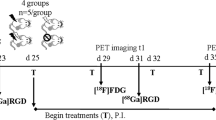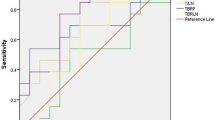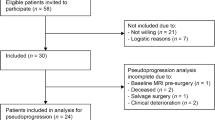Abstract
Purpose
To explore the relationship between metabolic uptake of the 18F-ALF-NOTA-PRGD2 (18F-RGD) tracer on positron emission tomography/computerized tomography (PET/CT) and the antiangiogenic effect of apatinib in patients with solid malignancies.
Materials and patients
Patients with measurable lesions scheduled for second- or third-line single-agent therapy with apatinib were eligible for this prospective clinical trial. All patients underwent 18F-RGD PET/CT examination before the start of treatment. Standardized uptake values (SUVs) of contoured tumor lesions were computed and compared using independent sample t-tests or the Mann–Whitney U test. Receiver-operating characteristic (ROC) curve analysis was used to determine accuracy in predicting response. Survival curves were compared using the Kaplan–Meier method.
Results
Of 38 patients who consented to study participation, 25 patients with 42 measurable lesions met the criteria for inclusion in this response assessment analysis. The median follow-up time was 3 months (range, 1–10 months), and the median progression-free survival (PFS) was 3 months (95% confidence interval, 1.04–4.96). The SUVpeak and SUVmean were significantly higher in responding tumors than in non-responding tumors (4.98 ± 2.34 vs 3.59 ± 1.44, p = 0.048; 3.71 ± 1.15 vs 2.95 ± 0.49, P = 0.036). SUVmax did not differ between responding tumors and non-responding tumors (6.58 ± 3.33 vs 4.74 ± 1.83, P = 0.078). An exploratory ROC curve analysis indicated that SUVmean [area under the ROC curve (AUC) = 0.700] was a better parameter than SUVpeak (AUC = 0.689) for predicting response. Using a threshold value of 3.82, high SUVmean at baseline was associated with improved PFS (5.0 vs. 3.4 months, log-rank P = 0.036).
Conclusion
18F-RGD uptake on PET/CT imaging pretreatment may predict the response to antiangiogenic therapy, with higher 18F-RGD uptake in tumors predicting a better response to apatinib therapy.




Similar content being viewed by others
References
Folkman J. The role of angiogenesis in tumor growth. Semin Cancer Biol. 1992;3:65–71.
Longo R, Gasparini G. Challenges for patient selection with VEGF inhibitors. Cancer Chemother Pharmacol. 2007;60:151–70.
Eskens FA. Angiogenesis inhibitors in clinical development; where are we now and where are we going. Br J Cancer. 2004;90:1–7.
Abdelrahim M, Konduri S, Basha R, Philip PA, Baker CH. Angiogenesis: an update and potential drug approaches (review). Int J Oncol. 2010;36:5–18.
U.S. National Library of Medicine (2009–2012) Efficacy study of [F-18]RGD-K5 positron emission tomography (PET) as a tool to monitor response to an anti-angiogenic drug. ClinicalTrials.gov Identifier: NCT00988936. Sponsor: Siemens Molecular Imaging
Winick J (2007 A proof-of-concept study to assess the ability of [18F]AH- 111585 PET imaging to detect tumours and angiogenesis. ClinicalTrials.gov; November 28, 2007 ed. US: National Institutes of Health; 2007.
Kerbel RS. Antiangiogenic therapy: a universal chemosensitization strategy for cancer. Science. 2006;312:1171–5.
Hurwitz H, Fehrenbacher L, Novotny W, Cartwright T, Hainsworth J, Heim W, et al. Bevacizumab plus irinotecan, fluorouracil, and leucovorin for metastatic colorectal cancer. N Engl J Med. 2004;350:2335–42.
Ruoslahti E. Specialization of tumour vasculature. Nat Rev Cancer. 2002;2:83–90.
Liu Z, Wang F, Chen X. Integrin alpha(v)beta(3)-targeted cancer therapy. Drug Dev Res. 2008;69:329–39.
Danhier F, Le BA, Preat V. RGD-based strategies to target alpha(v) beta(3) integrin in cancer therapy and diagnosis. Mol Pharm. 2012;9:2961–73.
Beer AJ, Haubner R, Wolf I, Goebel M, Luderschmidt S, Niemeyer M, et al. PET-based human dosimetry of 18F-galacto-RGD, a new radiotracer for imaging alpha v beta3 expression. J Nucl Med. 2006;47:763–9.
Xiong JP, Stehle T, Zhang R, Joachimiak A, Frech M, Goodman SL, et al. Crystal structure of the extracellular segment of integrin alpha Vbeta3 in complex with an Arg-Gly-Asp ligand. Science. 2002;296:151–5.
Yu YP, Wang Q, Liu YC, Xie Y. Molecular basis for the targeted binding of RGD-containing peptide to integrin alphaVbeta3. Biomaterials. 2014;35:1667–75.
Wan W, Guo N, Pan D, Yu C, Weng Y, Luo S, et al. First experience of 18F-alfatide in lung cancer patients using a new lyophilized kit for rapid radiofluorination. J Nucl Med. 2013;54:691–8.
Fontanella C, Ongaro E, Bolzonello S, Guardascione M, Fasola G, Aprile G. Clinical advances in the development of novel VEGFR2 inhibitors. Ann Transl Med. 2014;2:123.
Luan X, Huang Y, Gao S, Sun X, Wang S, Ma L, et al. (18)F-alfatide PET/CT may predict short-term outcome of concurrent chemoradiotherapy in patients with advanced non-small cell lung cancer. Eur J Nucl Med Mol Imaging. 2016;43:2336–42.
Shi J, Jin Z, Liu X, Fan D, Sun Y, Zhao H, et al. PET imaging of neovascularization with (68)Ga-3PRGD2 for assessing tumor early response to Endostar antiangiogenic therapy. Mol Pharm. 2014;11:3915–22.
Bao X, Wang MW, Luo JM, Wang SY, Zhang YP, Zhang YJ. Optimization of early response monitoring and prediction of cancer antiangiogenesis therapy via noninvasive PET molecular imaging strategies of multifactorial bioparameters. Theranostics. 2016;6:2084–98.
Yang G, Nie P, Kong Y, Sun H, Hou G, Han J. MicroPET imaging of tumor angiogenesis and monitoring on antiangiogenic therapy with an (18)F labeled RGD-based probe in SKOV-3 xenograft-bearing mice. Tumour Biol. 2015;36:3285–91.
Yang M, Gao H, Yan Y, Sun X, Chen K, Quan Q, et al. PET imaging of early response to the tyrosine kinase inhibitor ZD4190. Eur J Nucl Med Mol Imaging. 2011;38:1237–47.
Ji S, Zheng Y, Shao G, Zhou Y, Liu S. Integrin alpha(v)beta(3)-targeted radiotracer (99m)Tc-3P-RGD(2) useful for noninvasive monitoring of breast tumor response to antiangiogenic linifanib therapy but not anti-integrin alpha(v)beta(3) RGD(2) therapy. Theranostics. 2013;3:816–30.
Minamimoto R, Karam A, Jamali M, Barkhodari A, Gambhir SS, Dorigo O, et al. Pilot prospective evaluation of (18)F-FPPRGD2 PET/CT in patients with cervical and ovarian cancer. Eur J Nucl Med Mol Imaging. 2016;43:1047–55.
Strieth S, Eichhorn ME, Sutter A, Jonczyk A, Berghaus A, Dellian M. Antiangiogenic combination tumor therapy blocking alpha(v)-integrins and VEGF-receptor-2 increases therapeutic effects in vivo. Int J Cancer. 2006;119:423–31.
Brooks PC, Montgomery AM, Rosenfeld M, Reisfeld RA, Hu T, Klier G, et al. Integrin alpha v beta 3 antagonists promote tumor regression by inducing apoptosis of angiogenic blood vessels. Cell. 1994;79:1157–64.
Brooks PC, Clark RA, Cheresh DA. Requirement of vascular integrin alpha v beta 3 for angiogenesis. Science. 1994;264:569–71.
Kumar CC. Integrin alpha v beta 3 as a therapeutic target for blocking tumor-induced angiogenesis. Curr Drug Targets. 2003;4:123–31.
Stupack DG, Puente XS, Boutsaboualoy S, Storgard CM, Cheresh DA. Apoptosis of adherent cells by recruitment of caspase-8 to unligated integrins. J Cell Biol. 2001;155:459–70.
Zhang H, Liu N, Gao S, Hu X, Zhao W, Tao R, et al. Can an (1)(8)F-ALF-NOTA-PRGD2 PET/CT scan predict treatment sensitivity to concurrent chemoradiotherapy in patients with newly diagnosed glioblastoma? J Nucl Med. 2016;57:524–9.
Niu G, Chen X. RGD PET: from lesion detection to therapy response monitoring. J Nucl Med. 2016;57:501–2.
Acknowledgments
The authors would like to thank Ms. Laney Weber for excellent assistance.
Funding
This study was partially funded by Shandong Key Research and Development Plan (2017CXGC1209 and 2017GSF18164) and the Outstanding Youth Natural Science Foundation of Shandong Province (JQ201423), Jinan Clinical Medicine Science and Technology Innovation Plan (201704095), NSFC81372413, National Key Research and Development Program of China (2016YFC0904700).
Author information
Authors and Affiliations
Corresponding author
Ethics declarations
Conflict of interest
The authors declare no potential conflicts of interest.
Ethical standards
Our investigation was approved by the Shandong Cancer Hospital affiliated to Shandong University Ethical Committee. All persons gave their informed consent prior to their inclusion in the study.
Rights and permissions
About this article
Cite this article
Li, L., Ma, L., Shang, D. et al. Pretreatment PET/CT imaging of angiogenesis based on 18F-RGD tracer uptake may predict antiangiogenic response. Eur J Nucl Med Mol Imaging 46, 940–947 (2019). https://doi.org/10.1007/s00259-018-4143-8
Received:
Accepted:
Published:
Issue Date:
DOI: https://doi.org/10.1007/s00259-018-4143-8




